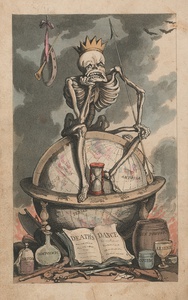| Method | Aquatint with original hand colouring |
| Artist | Thomas Rowlandson |
| Published | [London, Published March 1. 1816. by R. Ackermann, 101 Strand.] |
| Dimensions | Image 180 x 110 mm, Sheet 232 x 135 mm |
| Notes |
The decorative frontispiece for The English Dance of Death, a tragicomic series of plates by Thomas Rowlandson with accompanying rhyming verse by William Combe. The skeletal figure of Death, in an attitude of deep and abiding tedium or perhaps just simple exhaustion, sits dejectedly atop a globe, while storm clouds gather in the distance. Atop his bald pate sits a golden crown, and at his feet is his infamous hourglass. The long dart with which he strikes his quarry rests in the crook of his knee, while his clarion and shield hang behind. At the base of the globe are the many tools at his disposal for the ruin of mortal humanity: guns, knives, a large axe, currency, cards, opium, mercury, arsenic, a large barrel of gunpowder, and sundry other phials and philtres, all of which seem to be about to be consumed in the fires that rage in the background. Death's portrayal in this frontis is a superb comedic foreshadowing of the series, a suggestion that after the many hundreds of centuries of human existence in which Death has pursued his task, it is the ridiculous Regency Englishman who has finally driven him to exasperation. The English Dance of Death was Rowlandson and Combe's comedic English take on the popular danse macabre genre. The medieval danse macabre was at once both ribald and sombre, a subversion of social, politic, and religious hierarchies while at the same time a powerful reminder of the inescapable fate that awaits all mortals. The genre proved popular with printmakers, the most famous of which were undoubtedly those of Hans Holbein the Younger and Wenceslaus Hollar, but none are as satyrical as the English Dance of Death. The dance of death as a theme lent itself perfectly to a farcical excoriation of the foibles of Regency England, and Rowlandson and Combe, who had already established their comedic pedigree by collaborating on the popular Dr Syntax series, were the perfect pair to undertake it. In place of the Popes and paupers, the emperors and merchants, and the nuns and alchemists of the originals, in Rowlandson's plates, we find huntsmen and harlots, debauched nobles and pretentious churchmen, quack doctors and gin-shop wastrels, and a whole host of town and country characters beset by a Death who himself runs the full gamut of human emotion, from malice to exasperation, in the varied pursuit of his English prey. Thomas Rowlandson (1756 - 1827) was an English watercolourist and caricaturist. Born in London, the son of a weaver, Rowlandson studied at the Soho Academy from 1765. On leaving school in 1772, he became a student at the Royal Academy and made the first of many trips to Paris where he may have studied under Jean-Baptiste Pigalle. In 1775 he exhibited the drawing Dalilah Payeth Sampson a Visit while in Prison at Gaza at the Royal Academy and two years later received a silver medal for a bas-relief figure. As a printmaker Rowlandson was largely employed by the art publisher Rudolph Ackermann, who in 1809, issued in his Poetical Magazine The Schoolmaster's Tour, a series of plates with illustrative verses by Dr. William Combe. Proving popular, the plates were engraved again in 1812 by Rowlandson himself, and issued under the title The Tour of Dr Syntax in Search of the Picturesque. By 1813 the series had attained a fifth edition, and was followed in 1820 by Dr Syntax in Search of Consolation, Third Tour of Dr Syntax in Search of a Wife in 1821 and also in the same year by The history of Johnny Quae Genus, the little foundling of the late Doctor Syntax. Rowlandson also illustrated work by Smollett, Goldsmith and Sterne, and for The Spirit of the Public Journals (1825), The English Spy (1825), and The Humorist (1831). William Combe (1742-1823) was an English satirist and hack, best known for his authorship of the Dr Syntax series, which were illustrated with his long time collaborator Thomas Rowlandson. In his early life he travelled extensively, but as a product of his mounting debts, spent most of his later life in the King's Bench Prison. In addition to his work on the Dr Syntax series, he also wrote numerous spurious letter series, including some purporting to be by Lord Lyttleton that were widely considered to be authentic by his peers. In addition to his comedic works, he also produced a number of works of topographical history on London, the Thames, Bristol, and York. Condition: Trimmed within platemark, as issued, without loss to image. Minor time toning to sheet. Small tear to bottom margin, not affecting image. Old adhesive staining from album page on verso. |
| Framing | unmounted |
| Price | £250.00 |
| Stock ID | 52973 |

